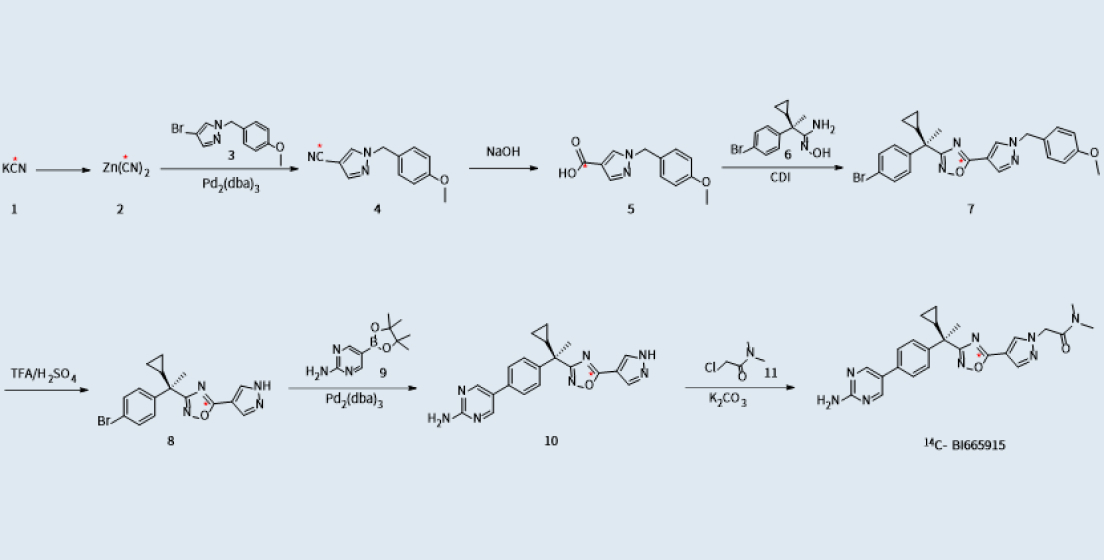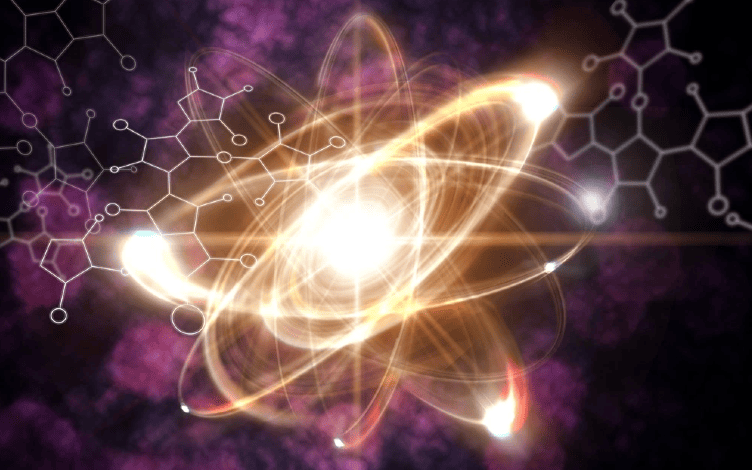-
Overview
-
Services
-
Case Study
-
Experience
-
Instruments
-
FAQs
-
Related Resources
-
Related Services
Overview
The carbon and hydrogen in the compound can be replaced by [14C] and [3H] without changing compounds’ chemical characteristics. Therefore, the chemical and physical properties of compounds labeled with [14C] and [3H] are very similar to those of the unlabeled counterparts. This method has been used in a wide range of applications, especially in the life sciences, including research and development of human and animal pharmaceuticals.
Our team of radiochemists is proficient in developing efficient radiosynthesis routes that can provide a variety of feasible options for the labeling positions of compounds, and provide professional advice, based on in vitro and in vivo metabolic data of compounds.
Learn More


Case Study
-
-


According to literature reports1, compound BI665915 is a novel selective 5-lipoxyylage activating protein (FLAP) inhibitor. It is better choice to incorporate carbon-14 atom on 1,2,4-oxadiazole ring. As shown as the hot synthesis route, it was successful to the synthesis of carbon-14 labelled compound BI665915 with the starting commercial material potassium cyanide [14C].
-
Experience
-
15+ years of radiolabeled compound synthesis experience
-
Radiolabeling different types of compound molecules
Instruments
-
-


Liquid Scintillation Counter
-


HPLC
-


Triple Quad MS
-


1H NMR
-
FAQs
Related Resources




-


GLP-1 Peptide Drug Radiolabeling and ADME Study Strategies
ArticlesDec 24, 2025Learn More -


Decoding Peptide ADME Challenges: Integrated Radiolabeled Synthesis & ADME Platform - DMPK Frontiers
VideosOct 24, 2025Learn More -


Mass balance, metabolic disposition, and pharmacokinetics of [ 14C] ensartinib, a novel potent anaplastic lymphoma kinase (ALK) inhibitor, in healthy subjects following oral administration
PublicationsOct 16, 2025Learn More -


Radiolabeled Synthesis and ADME Services
BrochuresOct 11, 2025Learn More -


The Application of Bile Duct Cannulation Animal Models in Radiolabeled Preclinical ADME Studies
PostersSep 11, 2025Learn More -


Radiolabeling Synthesis and ADME Profiling of GLP-1 Analogs: Strategies and Preclinical Insights
PostersAug 22, 2025Learn More -


Measurement of Phosphoinositide (PIP) Metabolism via Derivatization-Based Liquid Chromatography-Tandem Mass Spectrometry
PostersAug 12, 2025Learn More -


An Integrated Radiolabeling and ADME Platform for Peptide Drugs
WebinarsJul 17, 2025Learn More -


New Book Release: Drug Metabolism and Pharmacokinetics: Frontiers, Strategies, and Applications | WuXi AppTec DMPK
VideosJul 17, 2025Learn More -


Decoding DMPK Frontiers for Novel Therapeutics: WuXi AppTec DMPK’s New Book Release
BlogsJul 10, 2025Learn More -


Drug Metabolism and Pharmacokinetics: Frontiers, Strategies, and Applications
PublicationsJun 13, 2025Learn More -


High-Performance, Professional, Innovative: WuXi AppTec DMPK Accelerates Breakthroughs
VideosMay 22, 2025Learn More -


Metabolic disposition of [14C]-abivertinib, an epidermal growth factor receptor tyrosine kinase inhibitor: Role of glutathione conjugation
PublicationsApr 25, 2025Learn More -


Covalent Drugs DMPK Services
BrochuresApr 10, 2025Learn More -


Absorption, Metabolism and Excretion of Surufatinib in Rats and Humans
PublicationsApr 03, 2025Learn More -


Spotlight on Synthesis of Radiolabeled Compounds with DMPK Considerations and Applications in New Modalities
ArticlesJan 30, 2025Learn More -


WuXi AppTec DMPK: Your Trustworthy Partner
VideosDec 27, 2024Learn More -


Decoding DMPK Profiles of 37 FDA-Approved Peptides: Insights and Radiolabeling Considerations
BlogsOct 18, 2024Learn More -


List of Biological Sample Collection of Quantitative Whole-body Autoradiography (QWBA)
BrochuresAug 21, 2024Learn More -


Metabolite Identification of Nucleoside Analog Prodrugs in Biological Matrix by Derivatization Coupled with Radio-Detector and Mass Spectrometry
PostersMar 07, 2024Learn More -


Radiolabeled Mass Balance Studies in Preclinical Animals
PostersFeb 27, 2024Learn More -


Drug Metabolism and Pharmacokinetics (DMPK) Service
BrochuresOct 27, 2023Learn More -


Quantitative Whole-body Autoradiography (QWBA) Enables ADC Tissue Distribution Studies in Tumor-bearing Nude Rodents
BlogsAug 18, 2023Learn More -


Using Radiolabeling Techniques to Improve ADC Pharmacokinetic Studies
BlogsAug 18, 2023Learn More -


Application of Radiolabeling Techniques in ADC PK Studies
ArticlesJul 26, 2023Learn More -


Quantitative Whole-body Autoradiography (QWBA) vs. Mass Balance Studies
BlogsMay 04, 2023Learn More -


Tissue Distribution Using Quantitative Whole Body Autoradiography (QWBA) of [14c]-Paclitaxel in Tumor Bearing Mice
PostersMay 04, 2023Learn More
Reference
- 1.
Bachir Latli, Matt Hrapchak, Joe J. Gao, Carl A. Busacca, et al. A novel five-lipoxygenase activity protein inhibitor labeled with carbon-14 and deuterium. J. Label Compd. Radiopharm 2015, 58: 390–394.
Stay Connected
Keep up with the latest news and insights.









































